Red tailed hawk facts and trivia
No matter if you know a little or a lot about birds, you’ll definitely learn something new reading these red tailed hawk facts.
Fun facts and trivia about the red tailed hawk
Let’s start with some fun general red tailed hawk facts!
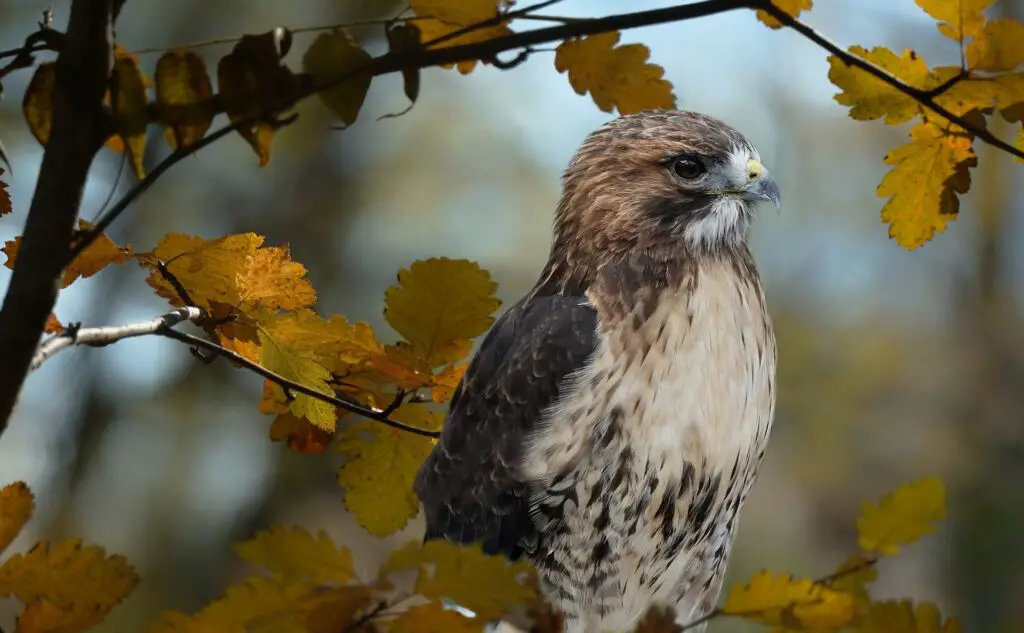
- In the movies, tv, and video games whenever you hear an eagle or falcon’s cry, it’s actually a red tailed hawk! The red tail’s vocalization sounds much more fierce than the peeping sounds bald eagles make.
- Red tailed hawks are also known as chicken hawks, buzzard hawks, and red hawks
- In Europe and Asia, hawks related to the red tailed hawk are known as buzzards and not hawks
- People who train red tailed hawks and other birds of prey for hunting are called falconers.
- It’s illegal to hunt or harass red tailed hawks under the Migratory Bird Treaty Act.
- Organizations like Cornell University have live cameras where you can watch red tailed hawks nesting, hatching, and learning to fly.
- In 1991, the first red tail was found nesting in New York City near Central Park!
- The first known written record about red tailed hawks was in 1788, when a German naturalist named Johann Friedrich Gmelin documented seeing them in Jamaica.
- Red tailed hawks and peregrine falcons are the most common birds of prey in North America
Facts about red tailed hawk’s appearance
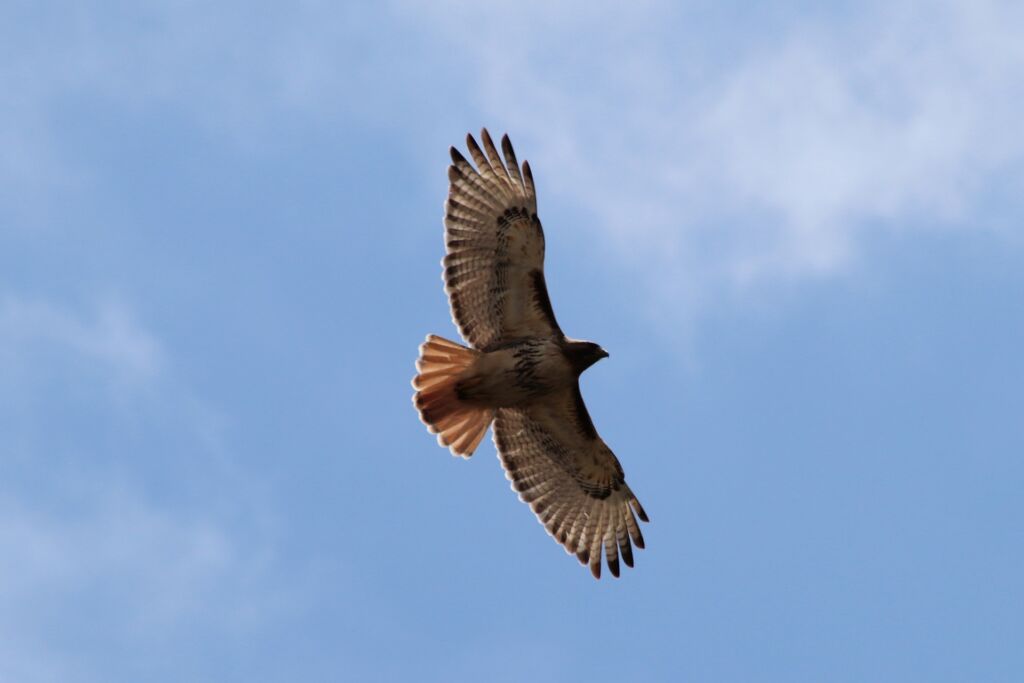
- Although they’re called red tailed hawks, younger red tails often have brown tails banded with black.
- A red tailed hawk’s eyes start off yellow and turn brown as it gets older
- The average red tail weighs between 2-4 pounds.
- Their wingspan is about 38-43 inches!
- Female red tails are about 25% larger than males.
- There are at least 14 different subspecies of red tailed hawks, and they have different appearances:
- Jamaican red-tailed hawk
- Alaska red-tailed hawk
- Eastern red-tailed hawk
- Western red-tailed hawk
- Central American red-tailed hawk
- Southwestern red-tailed hawk
- Tres Marias red-tailed hawk
- Mexican Highlands red-tailed hawk
- Harlan’s hawk
- Red-tailed hawk (kemsiesi)
- Krider’s hawk
- Socorro red-tailed hawk
- Cuban red-tailed hawk
- Florida red-tailed hawk
Here are the best hawk identifications to learn to tell them apart.
Behavior
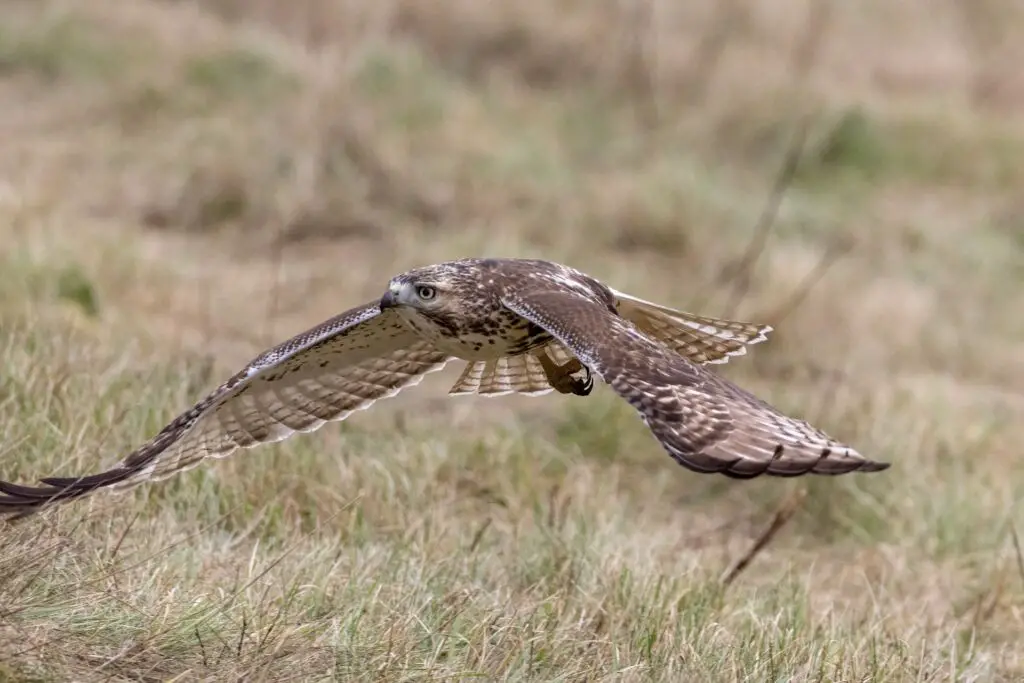
- When soaring or flapping, red tailed hawks fly around 20-40 mph.
- And when diving after prey, they can reach up to 120 mph!
- Red tailed hawks have fantastic vision and can see a mouse on the ground when they’re perched high in a tree
- Red tailed hawks can see in color and ultraviolet
- They have a second type of eyelid that allows them to see but protects their eyes while attacking prey, called a nictitating membrane.
- Hawks that live in Alaska, Canada, and the northern United States migrate south for the winter. (read more about hawk migration here)
- Red tailed hawks sometimes work as a team to hunt prey and prevent animals like squirrels from escaping!
Lifecycle
- Did you know red tailed hawks are monogamous? They mate for life and only find a new mate if the first one dies.
- Red tails often return to the same area to nest each year and sometimes reuse or rebuild their old nests. (learn more about bird of prey nests and nest boxes here!)
- The mother usually lays 1-3 eggs but can lay as many as 4-6!
- Both the mother and father incubate the eggs until they hatch
- After the eggs hatch, the mother primarily stays in the nest whille the father hunts.
- Their chicks are called eyasses (pronounced “eye-ess-ez).
- The average red tailed hawk lives for 6-7 years in the wild.
- The longest lived wild hawk lived 25 years!
- In captivity, red tails have been recorded to live up to 29 years.
Habitat
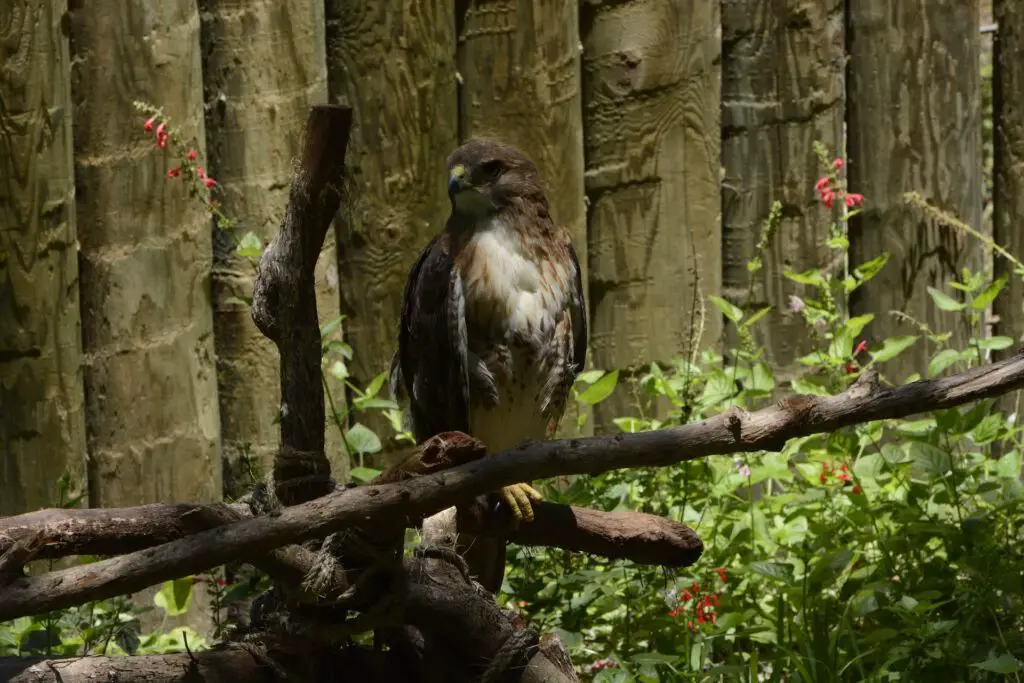
- Red tailed hawks are the most common hawk in the world.
- Red tails live in almost any habitat- deserts, plains, forests, farmer’s fields, suburbs and cities!
- Because they live in so many areas, red tailed hawks nest in trees, cacti, cliffs, and even in cities on top of buildings, billboard platforms, and radio towers.
- And red tailed hawks live almost everywhere on North America, from Alaska and Northern Canada to Mexico and the Gulf of Mexico!
Prey
- Red tails prefer to eat mammals like mice, chipmunks, rats, squirrels, and ground squirrels
- Occasionally, they eat quail, pheasant, grouse, snakes, and lizards.
- And they’ve rarely been seen digging up and eating earthworms, catching bats and fish, and even roadkill!
- While a red tailed hawk could attack a cat or dog, it’s unlikely unless they are bothering the hawk’s nest.
Predators
- Great horned owls and eagles are red tailed hawks main predators.
- And great horned owls hunt the same prey as red tailed hawks. Only they hunt at night while hawks hunt during the day.
- Crows, great horned owls, raccoons, foxes, and snakes all eat red tailed hawk eggs.
Appearance
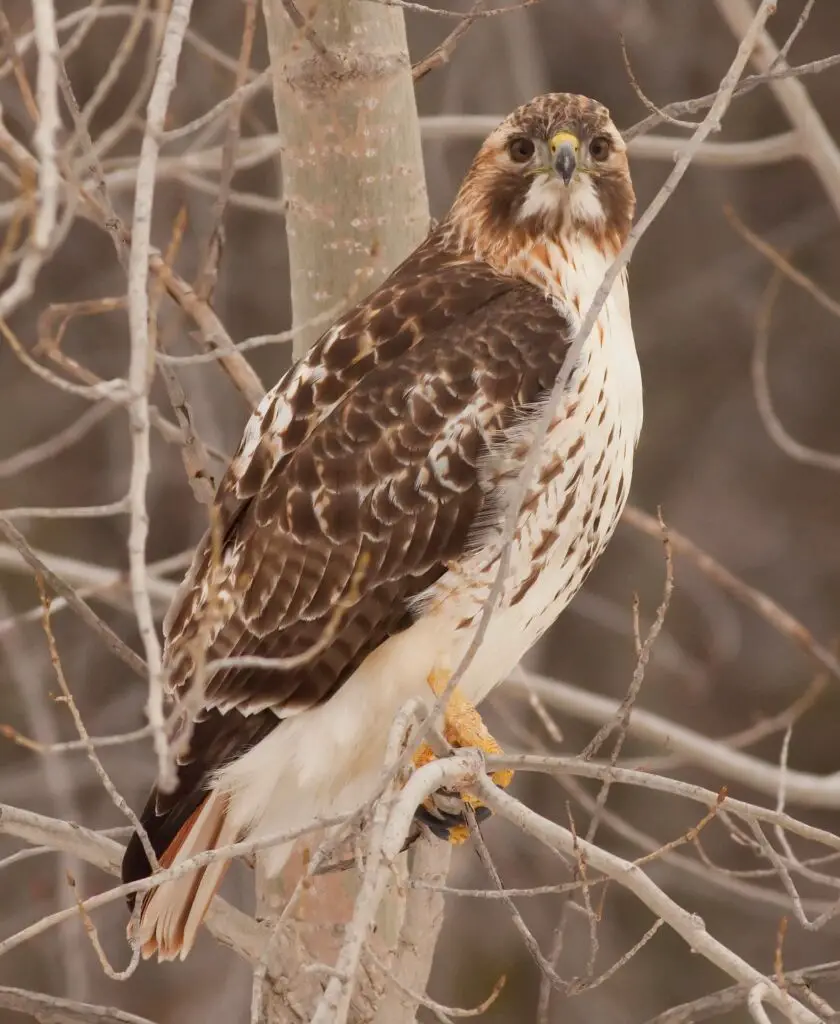
- Body length: 18-26 inches
- Wingspan: 38-43 inches
- Weight: 24.3-51.5 ounces (1.5-3.2 pounds)
How to identify red-tailed hawks in 4 simple steps
Red tailed hawk eye color
Did you know that a red tailed hawk’s eye color changes as it gets older?
A young hawk’s eyes are yellow and they change to brown over time. However, each individual hawk is different, so you can’t use eye color to tell their exact age.
Source: Hawk Watch International
Eyesight
Red tailed hawks have excellent vision. They can see colors and even colors in the ultraviolet range, which humans cannot!
Their fantastic eyesight helps them find and catch prey from far away.
Red tails also have an extra eyelid. This transparent eyelid is called the nictitating membrane. It protects the hawk’s eye while it’s catching prey.
[Source]
Prey
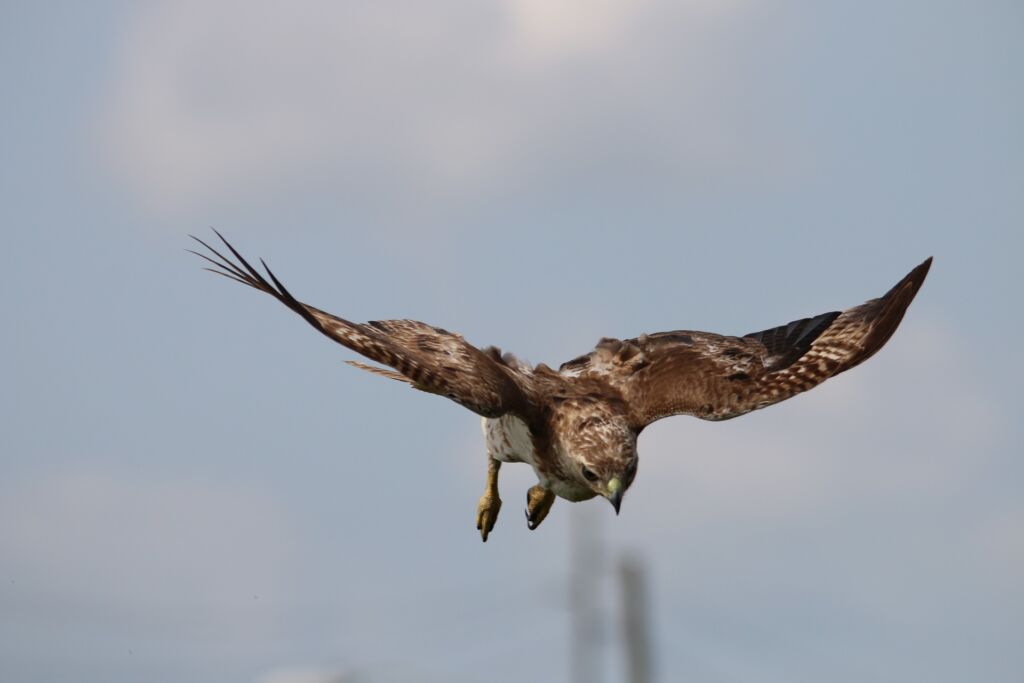
Red tailed hawks typically eat mice, squirrels, chipmunks, rabbits, rats, groundhogs, shrews, voles, gophers, and other mammals.
Less commonly, they may also eat birds like woodpeckers, crows, jays, red-wing blackbird, ducks, geese, quail, pheasant, and grouse; reptiles like snakes; frogs, toads, bats, weasels, ring-tailed cats, foxes, raccoons, insects like beetles and grasshoppers; crabs, the occasional fish, and even carrion.
In fact, red tails in Texas hunt bats, and ones in Florida occasionally eat earthworms after it rains [source].
And red tailed hawks (though rarely) have preyed on domestic cats and even a lamb!
It all depends on what type of animals live in the area and the season!
Red tailed hawk predators
Red tailed hawks only have few predators: great horned owls, eagles, and other large hawks.
In addition, crows, great horned owls, raccoons, foxes, and snakes prey on red tailed hawk eggs.
Source: San Diego Zoo
Red tailed hawk habitat
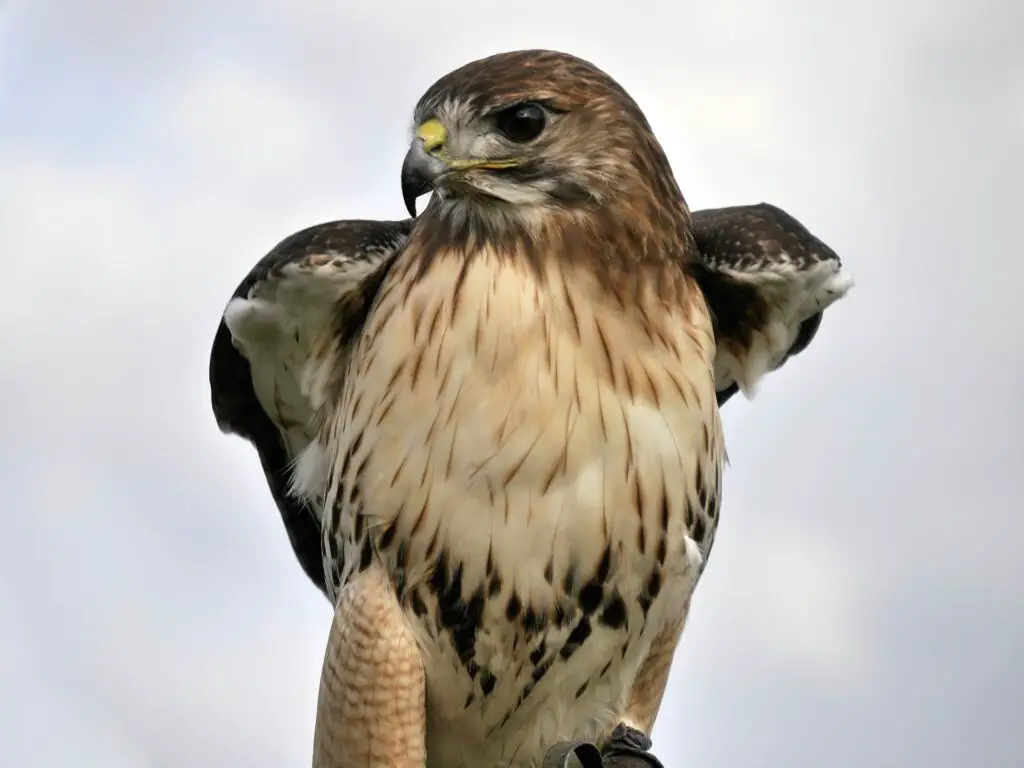
Red tails live all over North America- from Alaska and Canada to Mexico, the Caribbean, and everywhere in between!
Red tailed hawks prefer to live in open areas like fields or deserts. They look down on these wide open spaces from high perches like trees and telephone wires. This gives them a great view to search for their prey!
And sometimes you may see them soaring high above in the sky looking for prey.
Flight
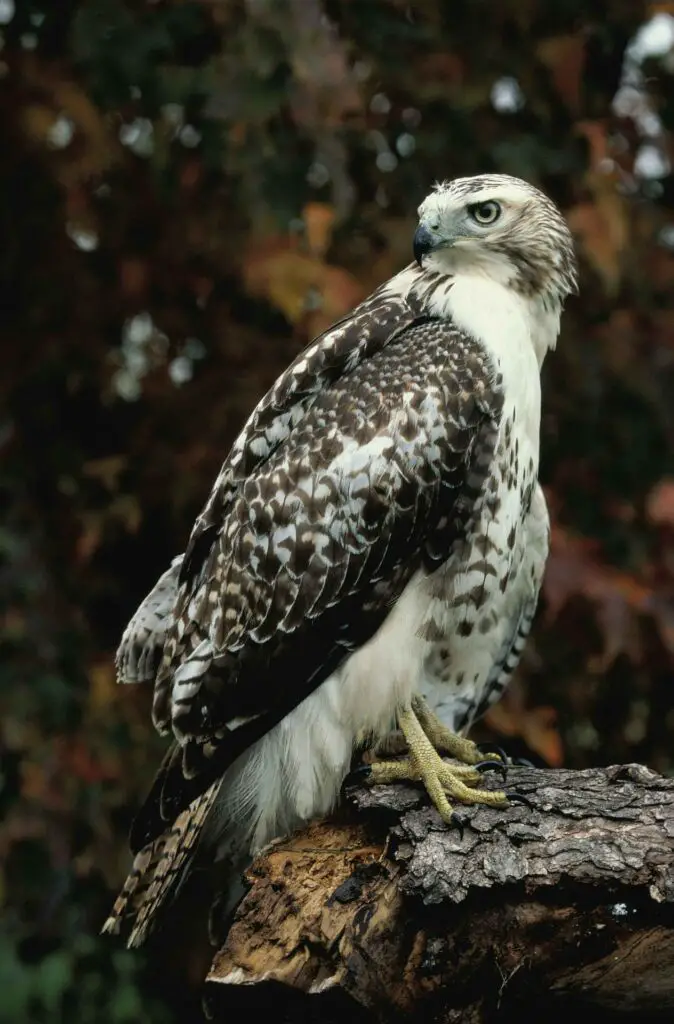
When they are hunting, red tailed hawks perch somewhere up high. Once they spot prey, they dive down to catch it.
During courtship, red tails fly in large swooping circles. And the male may dive quickly to impress his potential mate!
Sometimes the male will fly up and down in a roller coaster pattern around the edge of his territory.
Inspiring quotes about red-tailed hawks
Breeding
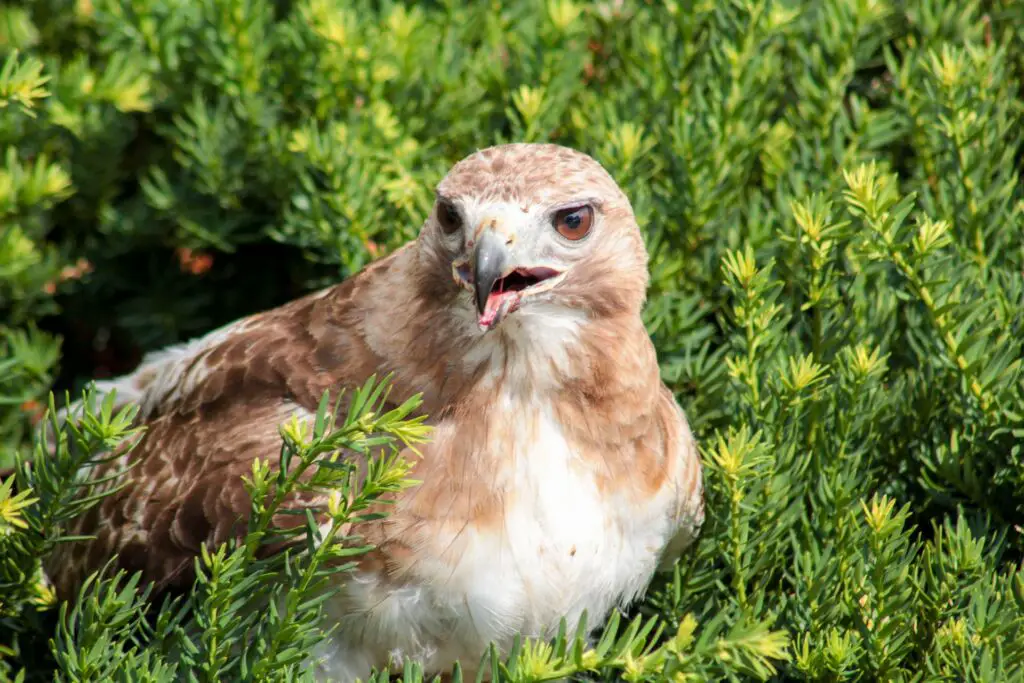
Red tailed hawks mate for life!
Together, the male and female build a nest out of sticks about 15-70 feet off the ground. Usually, they nest in trees, but also build them on top of skyscrapers, radio towers, and on cliff ledges.
The female typically lays 1-3 eggs but may rarely lay 4, 5 or even 6 eggs!
Both parents incubate the eggs for 28-35 days. And then they take 2-4 days to hatch. After they hatch, the female cares for the young and the male hunts.
The chicks are called eyasses (pronounced “eye-ess-ez).
For the first few days, mom tears their food into small pieces. But they quickly learn to peck the food themselves.
And the eyasses are more and more active each day! After about 30 days, they flap their wings regularly to practice flying. And after about 45 days, they rip their own food and begin leaving the nest. Once they’re around 4 months old, the red tailed hawks leave the nest for good and become independent from their parents.
Once the young are 3 years old, they’ll be ready to breed.
You might also enjoy: free raptor identification guides
FAQ
What are red-tailed hawks known for?
Red-tailed hawks are known for their brick red tails.
However, there are many varieties all with different colorations.
What are the predators of the red-tailed hawk?
The predators of the red-tailed hawk are great horned owls and eagles.
Are red-tailed hawks rare?
Red-tailed hawks are common and found all across North America, from Alaska and Canada to California, Mexico, and the Caribbean.
Red tailed hawks are not endangered.
[Source]
Where do red tailed hawks live?
Red tailed hawks live all across North America. They live in a variety of habitats, including grasslands, forests, deserts, mountains, and urban areas
Where do red tailed hawks build their nests?
Red tailed hawks build their nests near the top of tall trees. They may also build them on radio towers, billboard platforms, or even on top of tall buildings!
Do red tailed hawks return to the same nest every year?
Red tailed hawks occasionally return to the same nest every year. They may build a new nest nearby, reuse their old nest, or even use a nest they built several years ago.
Do red tailed hawks migrate?
Red tailed hawks from Alaska, Canada, and the northern United States typically migrate south for the winter.
Hawks living further south usually do not migrate.
How long does a red tail hawk live?
The average red tailed hawk lives for 6-7 years in the wild.
The longest lived wild hawk lived 25 years! In captivity, red tails have been recorded to live up to 29 years.
Do red-tailed hawks eat birds?
Red- tailed hawks do not primarily eat birds. However, when they do eat birds, they prefer grouse, pheasant and quail. They also prey on northern flickers, which are ground- based woodpeckers. In addition they eat crows, Steller’s jays, meadowlarks, redwing blackbirds, and starlings.
Can a red tail hawk kill a dog?
It is unlikely that a red tail hawk will attack or kill a dog.
If a pet gets too close to a hawk nest, the hawk may attack to defend their nest.
How many babies do red-tailed hawks have?
Red-tailed hawks typically lay a clutch of 1-3 eggs, but rarely lay 4-6 eggs.
How fast can red-tailed hawks fly?
When soaring or flapping, red-tailed hawks fly from 20-40 miles per hour. When diving, they may reach speeds of up to 120 miles per hour.
Are red tailed hawks friendly?
Red tailed hawks do not normally attack humans. In addition, they are more sociable and trainable than most other types of hawks and falcons, so they’re often used by novice falconers.
Source
More red tailed hawk facts and reading
These websites have many more fantastic red tailed hawk facts, on everything from their migrations, to what they eat, where they live, and how the different types of red tailed hawks look!